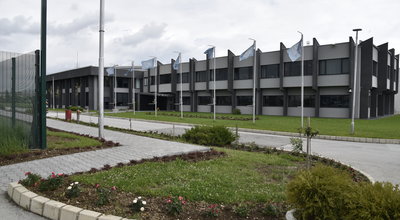By – Jun 1, 2014
The smokestacks at Kosovo’s oldest power station tower over decaying buildings and a tangle of rusty pipes, polluting the Balkan countryside and posing the first test of the World Bank’s pledge to avoid coal.
The half-century-old plant near the capital, Pristina, produces a third of the nation’s electricity by burning lignite, a type of coal that emits more greenhouse gases than any other fossil fuel and is blamed for hundreds of premature deaths a year in Kosovo. Chronic power outages hobble the country’s $7 billion economy, the poorest in Europe after Moldova.
Kosovo’s government is asking the World Bank to help finance a new plant that would provide a reliable power supply while still tapping the nation’s lignite reserves, the world’s fifth largest. The proposal is forcing the lender and its biggest shareholder, the U.S., to make an exception in their clean-energy commitments and concede that burning coal can be the fastest route out of poverty.
“We’re going to avoid coal except in the most exceptional circumstances, and in this case, it is one of the exceptional circumstances,” World Bank President Jim Yong Kim said in a May 30 interview. “It’s a dilemma, not just as the World Bank — it’s a dilemma all over the world.”
Boosting growth and attracting foreign investment while agreeing to close the old plant means the country of more than 1.8 million people needs new sources of electricity. The debate with environmentalists is whether that can be achieved without coal, an abundant resource that’s been a source of pride in the former province of Yugoslavia.
Shifting Mindset
“All these years, we have not been able to think about anything else,” said Visar Azemi, who coordinates Kosid, a coalition of non-profit organizations, media and research institutes that oppose a new plant, in an interview in Pristina. “To talk to people about shifting this mindset to renewables, to something else besides coal, was not an easy task to do.”
Containing less energy and more carbon, lignite is cheaper than hard coal and has seen a recent revival in Europe as policy makers allowed mines to be expanded to drive down power prices.
The Kosovo project — a two-unit, 600-megawatt plant that would be fed coal from nearby state-owned mines — is estimated by the government to cost less than 1 billion euros ($1.4 billion). It would be built with private funds and sit next to Kosovo’s second power plant, which dates back to the 1980s and needs upgrades.
Lining Up
U.S. and European companies are lining up to bid on the project. New York-based ContourGlobal LP and Sithe Global Power LLC, which is owned by funds managed by Blackstone (BX) Group LP, were pre-approved as bidders, along with Turkish company Park Holding AS, according to Economic Development Minister Fadil Ismajli. Public Power Corp SA, Greece’s largest electricity company, is partnering with Sithe Global, he said in an interview earlier this year.
To lure investors and their financiers spooked by political or credit risks, the World Bank would offer about $60 million in loan guarantees that would kick in if the government failed to meet obligations such as supplying coal or purchasing electricity. Such guarantees ensure the bank gets involved early on in disputes and helps avoid such crises.
Years without investment have curtailed the two plants’ capacity, making outages part of daily life in Kosovo and forcing the state-owned utility to import more expensive electricity. More than a third of the power available is lost during transmission and distribution or is never billed.
Winter Nights
On winter nights, the smell and haze from wood-burning stoves waft through the streets of Pristina, a city of more than 200,000 inhabitants where Ottoman-era monuments sit beside concrete-block tenements built during the Cold War.
The country has “obsolete technologies which are highly polluting and are not sufficient to meet even the basic demands for growth and development of the economy,” Ellen Goldstein, the World Bank’s country director for Southeast Europe, Europe and Central Asia, said in a phone interview.
The Washington-based bank looked at all options before concluding that the best way to meet current and future demand is to build a new, more efficient coal-fired plant and complement it with renewable sources, which the government has pledged to expand, Goldstein said. The bank also plans to fund efforts to insulate government buildings.
For Kosovo, which declared independence from Serbia in 2008 and is not recognized by Russia or China, coal also means security of supply, Ismajli said in an e-mail.
Cheap Supply
Russia’s annexation of Crimea earlier this year and the instability engulfing Ukraine “demonstrate the importance of developing indigenous resources,” he said. “Kosovo has an abundance of high-quality lignite that is cheap and easy to extract.”
Kosid and its international allies, which include the U.S.- based environmental group Sierra Club, say a new lignite-fired plant is avoidable.
“There are better, cheaper, smarter options, which also happen to be lower emitting,” said Bruce Buckheit, a former official at the U.S. Environmental Protection Agency who worked as a consultant on Kosovo for the Sierra Club. Among the potential sources of energy is natural gas from Azerbaijan, he said.
Opponents of the plant also promote a renewable-only proposal crafted by Daniel Kammen, who heads the Renewable and Appropriate Energy Laboratory at the University of California at Berkeley, and spent a year advising the World Bank on the issues. His low-carbon scenario uses more optimistic assumptions for wind-, solar- and biomass-generated power than the bank.
Opposition Funding
Kosid, which has financial backing from the Rockefeller Brothers Fund, has campaigned against the government plan, citing the bank’s own estimates that air pollution causes more than 800 premature deaths in Kosovo each year.
“The high cost of building a new coal plant will go into your energy bills,” Kosid says in an animated television advertisement released last month in Kosovo. “And the health-care treatment for thousands that will fall sick from the pollution, that’s also an economic cost of coal.”
The goal for the activists is ultimately to dissuade the bank from supporting the project. The bank has become a bigger advocate for clean energy development during two years under Kim, a physician and anthropologist by training.
“We just cannot tell them that they can’t have energy because we can’t invest in coal,” Kim said in the interview. “We’re going to at least make this coal-power plant the cleanest it could possibly be.”
Rare Cases
Last year, the lender said it would stop financing coal projects except in rare cases “where there are no feasible alternatives available to meet basic energy needs and other sources of financing are absent.”
Kosovo’s future with coal is “a test of the ambiguity they’ve left on the table,” said Scott Morris, a former deputy assistant secretary for development finance and debt at the U.S. Treasury Department. “It’s a dilemma for the bank in that there’s no doubt that any coal project has a climate impact.”
The lender last financed a coal-fired plant four years ago, in South Africa. While the project was approved, several countries, including the U.S., abstained from the board vote.
This time, the bank’s largest member-nation appears more supportive, with officials from the U.S. Agency for International Development recommending the project in a September report.
Treasury Secretary Jacob J. Lew said during a May 8 congressional hearing that “for the poorest countries, we continue to have an exception for coal facilities.”
Board Decision
Treasury Department spokeswoman Holly Shulman said the U.S. won’t make a final decision until the project is brought to the bank’s board, which has yet to schedule a review.
The timing is less than ideal for President Barack Obama as he makes a case for acting on climate change. As a result of proposed EPA regulations scheduled to be released today, the U.S. Chamber of Commerce predicts coal use in power generation would plummet.
The U.S. and Kosovo have a close relationship that dates back to the war of 1998-99, when the U.S. pushed the North Atlantic Treaty Organization to conduct air strikes to end an ethnic conflict between Serbs and Kosovar Albanians.
In Pristina, a statue of Bill Clinton welcomes visitors driving from the airport on a boulevard that bears the former U.S. president’s name. It intersects with a street named for George W. Bush, Clinton’s successor, who supported the country’s independence.
Government Mine
Kosovo’s government, which will retain ownership of the mine supplying the proposed plant, in April asked the companies to start the bidding, the economic ministry said in an e-mail.
The older of the two main plants may remain open through 2021 or 2022, until a new one is operating, said Ismajli, the economic development minister.
A few miles away, Ragip Grajcevci, 49, operates excavators in coal fields that are moving closer to his village, Hade.
Fearing the mine’s expansion will eventually displace his family, Grajcevci is seeking job guarantees for young people in his town, despite the toll he says coal has taken on his own health. Kosovo’s reliance on burning coal for electricity and its impact on air quality aren’t among his immediate concerns.
“Whether we want it or not, the government has decided,” he said at a cafe in the town of Obiliq, where the smokestacks and cooling towers of the coal-fired power stations crowd the skyline. “It’s a done deal.”












